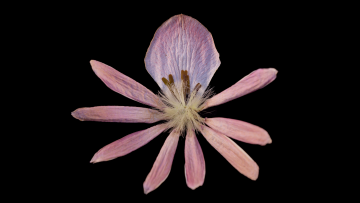Katrina Vera Wong exhibits hybrid flowers (Frankenflora) made from various approaches.

Next Spring
March 11 – June 28, 2020
Extended to November 1, 2020
Artist Biography:
Katrina Vera Wong is an artist, writer, and editor. Learning from literature, botany, herbaria and ikebana, she makes flowers from dried or pressed plants and calls them Frankenflora. She currently writes about sciart as a subject editor at Science Borealis, a Canadian science blog, and edits in full-time and freelance capacities. She is also the creator of Seagery Zine, a small annual print publication that explores the overlap between art, science and literature. Check Katrina’s Instagram and website!
Artist Statement:
I make flowers called Frankenflora — imagined hybrids that are pieced together from parts of dried or pressed plants. Where it’s genetically impossible to combine several species or genera, my work mimics the technique Dr. Frankenstein used to create his being.
When flowers fall, it’s not a sad affair. There’s beauty in a rain of petals and hope in knowing new blooms will emerge next year. Perhaps it’s why Samuel Taylor Coleridge wrote a poem that spoke of a “strange and beautiful” flower that could be plucked from your dream in heaven and later, upon waking up, appear in your hand. The idea of a flower crossing the plane between life and death became essential when my father died. I had to face the fact that nothing could bring him back. So I made a flower and prayed that it could somehow keep us connected.
As I worked through the immediate storm of grief, I honed my skill in handling small, fragile fragments of plants, learning to be gentle with myself and with the material. Initially, my flowers resembled those pressed and mounted onto herbarium sheets, but they eventually peeled themselves off the page, seeming as though I’d just plucked them from the earth.
From ikebana, Japanese flower arrangement, I learned to observe and enhance the connection between different plants and between plants and us. Making or arranging a flower in a container draws from the container’s form and colours, craftsmanship (from the container’s maker), memory (from the container’s owner), and space (within the container). It’s a challenge that produces a flower imbued with greater meaning. The Sogetsu school of ikebana also uses unconventional materials in their arrangements, which is leading me to incorporate bleached or dyed plants in my practice.
Wanting to make flowers with intent, by knowing which plants I was using and how I was arranging them, I started designing flowers for particular environments. The world’s flora have evolved curious morphologies and compositions, specially adapted to the areas they happen to germinate in and the pollinators they might rely on. In my research, I marvelled at the structural and chemical means with which plants thrive, and sought to puzzle out combinations for future flowers.
Frankenflora (with its variations given binomial names) tend to highlight parts of plants that are usually hidden or ignored by placing them in a new context at a new angle. Leaves become petals, branches become roots, or even become a new structure. That these flowers are genetically impossible is a fact, but it has opened doors to what my practice can create.
I’ve presented here a range of Frankenflora taken from different points along the road of progress. I am currently working on the final stage of Dr. Frankenstein’s method: reanimation. Who knows what next spring will bring?
Exhibition Contributors:
Curator
Yukiko Stranger-Galey
Scientific Curator
Linda Jennings
Designer
Derek Tan
Fabricator
Lesha Koop
